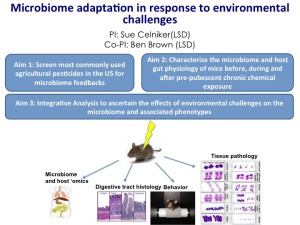
PIs: Sue Celniker (LSD), Ben Brown (LSD)
Everyday we are exposed to a wide variety of chemicals through contamination of our water, air and food supplies. Of the >60,000 compounds industrial compounds, fewer than 7% have been toxicologically characterized in any system. Public health risks include increased cancer, immune diseases, decreased mental abilities and other behavioral affects. Increasing evidence suggests an interaction between the gut microbiota, the gut and other organ systems, including the brain and liver. However, the effects of chemical exposures on the microbiome and animal physiology are poorly understood. Humans have more microbial cells than mammalian cells; most individuals carry between one and six pounds of bacterial mass as part of their body weight. The microbiome is known to effect everything from mood to susceptibility to obesity and heart disease. We hypothesize that environmental exposure to pesticides has an influence on the composition, organization and function of the gut microbiome. These changes can result in disease that depends on the age at the time of exposure, genetic background and dosage. Alternatively, gut microbes may counteract the effect of some environmental toxins by degrading them into less toxic forms. Unfortunately little information exists to make such predictions. This study will identify the role of the gut microbiome in individual responses to pesticide exposure, and will serve as a model for our future studies aimed at understanding how the gut microbiome mediates individual susceptibility to chemical and other environmental contaminants.
A unique aspect of our study is that we conduct toxicological exposures at environmentally relevant doses. In classical toxicology, high, usually near-lethal doses are studied. It may be that health effects manifest from chronic, low-dose, but not acute exposure. For instance, millions of Californians are regularly exposed to pesticide aerosols at extremely low (ng/m3) concentrations. Current recommendations from the Environmental Protection Agency suggest that these concentrations are not harmful to human health. However, these recommendations are based primarily on acute, one-time exposures. Furthermore, it may be that these concentrations, while not harmful to humans, are detrimental to keystone agricultural pollinators like bees and butterflies. We will study the results of chronic exposure in both insect and mammalian models, and will endeavor to gain insight into how these compounds affect human and natural ecologies in California and beyond.
